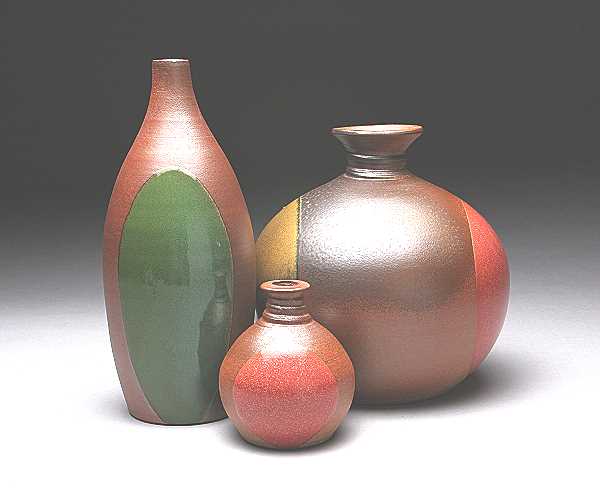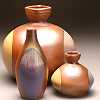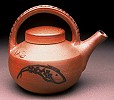
Bernard Leach: Catalyst by Gary C. Hathcer, The Studio Potter
In 1998 and 1999 Gary C. Hatcher served as guest editor for The Studio Potter compiling two issues of the magazine comprised of articles by noted writers, scholars, ceramic artists and other contributors. Among those invited by Hatcher to write were Susan Peterson, Richard Wilson, Ellen Conant, Garth Clark, Jack Troy, Rob Bernard, Emanuel Cooper, Brian Moeran, Scott Bessho, John McElroy, Stephan Emmelmann and Kevin Crowe. The forcus of the effort was entitled, "Alternative Perspectives of Bernard Leach". Full text of the articles by the abovementioned writers are available by ordering back issues of The Studio Potter their web site. What follows is the introduction to part I in the December 1998, Volume 27, Number 1 issue.
Bernard Leach: Catalyst
by Gary C. Hatcher
"Life can only be understood backward but it must be lived forward."
SÖren Kierkegaard
'Alternative Perspectives on Bernard Leach' seeks to offer insight and understanding into a persona that dramatically and irreversibly changed our world of clay. This collection of writings is not about digging up old bones and going over what has already been well documented regarding Bernard Leach. Homage has been paid Leach over and over again by the Japanese, by his homeland, by his apprentices and hundreds of protégé. And unlike most artists, Leach wrote much about himself and his circle.Appreciation of a good pot requires attentiveness and awareness of all attributes. The foot, shape, inside and out and historical information about the origin and intent of the maker are helpful to our understanding. This collection of articles aspires to shine a bright light providing further understanding on the philosophy and historical significance of Leach, just as we would study a pot. Without exception all contributors regard him with great respect and recognize his unequaled significance in twentieth century ceramic art, but not all perspectives are flattering. Some included call into question events that have conflicting reports, as with his claimed inheritance of the Kenzan VII title or the illusionary castle of mingei built with the help of friends that has gained popularity as a model for evaluating "good pots" today. Included are personal perspectives of lives redirected by the powerful potion Leach administered. Mine has been such a life.Thumbing through A Potter's Book1 evokes the same feelings as walking through my childhood neighborhood. Feelings of excitement, pain, memories of new discovery are brought back by signs and symbols not seen in awhile. So familiar and yet so far away from the world in which I now make pottery. A Potters Book2 was the beginning for me. This was the beginning of a 25-year journey that has encompassed all of my adult life. In 1973 when I first picked up A Potters Book3 I had no intention of becoming a potter. I was a psychology and philosophy major in college, but I was only one of hundreds whose life was redirected by the writings and pulpit-pounding of Leach. The individuals invited to participate in this first part of 'Alternative Perspectives on Bernard Leach' all have personal perspectives that differ. It is difficult to find someone working with clay today that has an indifferent opinion of him. Also, much is misstated and misunderstood about Leach.Leach was no longer taking apprentices in 1976 when Daphne and I traveled to England and he was almost totally blind. Janet Leach was running St. Ives Pottery and our connection with her was that she, too, was from Texas. Her birthplace, Grand Saline, Texas, is only 20 miles from where we have had our pottery for 20 years. So we had a common link with Janet: Texas. We visited her numerous times at St. Ives and when she came to Texas she would come to visit us. The first of several meetings we had with Leach was at his 90th birthday party. You had only to select a topic and an oratory was yours: American potters, clay bodies, Hamada. Many topics would provide the most entertaining and eloquent speeches. I could not say that I ever really had a conversation with him, but I did listen and he did change my life. Daphne and I lived and worked in the studio of Michael Leach and then for a longer time with David Leach, both of Bernard's sons, as well as spending many pleasurable hours at Michael Cardew's home and studio. We were in the middle of it; we were submerged in Leachism for almost three years. This special privilege was, of course, just that: a privilege. But the privilege also came with some heavy baggage. My art school training in the states had provided nurturing of my ego and offered the latitude to experiment. The apprenticeship training was focused on the needs of the workshop. Ego was transcended. This, of course, is the way it should be in an apprenticeship situation. I have had many people working in my studio over the last twenty years and the ones who learned were the ones willing to let go. An apprenticeship can serve as a secure grounding, that if not transcended through realization of a personal creative voice can be stifling.Janet Leach once told me that she could not understand why so many potters copied Leach. "Bernard was the great granddaddy of the 'do your own thing' generation. Bernard did not want to see his students making his pots." As with any powerful teacher, artist, philosopher or writer (Leach was all four), followers risk being pulled under by a vortex of charismatic presence. C.G. Jung was one of many of Sigmund Freud's protégés that studied and learned from the master, but went on to challenge all that Freud espoused. Following a natural course, he went on to provide the world with his own explanations of the human psyche, his own voice shone through with clarity influenced by, but not emulative, of Freud's. Looking through the recently published book The Leach Legacy4, which profiles St. Ives Pottery apprentices, it appears that many of Leach’s students were pulled under by his charisma, adapting his solutions of creativity as their own. A few have traveled beyond the influence and programming of the St. Ives experience to truly draw from an internal well-spring transcending their apprenticeship. A few that come to mind are Gwynn Hanssen Pigott, Richard Batterham and Jeff Oestreich.Some of Leach's observations were exceedingly circumspect while others were generalist and exaggerated. All of art is metaphorical and it is important to see Leach's art inclusive of his writings as a metaphorical work in progress. He was not an art historian documenting events of history. He was a practicing artist witness to an era of dynamic change not only in England but also in the East and in America. His philosophical side attempted to explain the changes taking place as a result of the industrial revolution from handcraft workshops to mass production factories.Leach was focused on the past. Repeatedly in his writings he looked over his shoulder, romanticizing earlier times. He embraced the ideas of poet, artist and reformer, William Morris. The Middle Ages were identified as a time of great artistic and creative renaissance to be returned to. Many historians also refer to this period celebrated by Leach as 'The Dark Ages'. The writer Lafcadio Hearn, who in his writings beckons us to return to an earlier time in Japan, significantly influenced Leach. "Ever since I started at the London school, I had contemplated going to Japan in order to try to understand Eastern art and the life behind it. The books written by that stylist who first described Japanese life and culture in sensitive English-Lafcadio Hearn- had aroused in me the desire to return to the East where I was born…in the spring of 1909 I sailed for Japan, third class on board a German liner."5 Americans' forward looking gaze and progressive attitude was particularly disconcerting to him. "When we reached America we encountered thousands of self-conscious individual craftsmen without root and without the desire or capacity to cooperate. We recognized this as reaction from mechanization. My distaste with over-stressed individualism grew stronger. I admire most the art in which there is a power greater than that of the individual…"6 Mingei was the embodiment of the romantic return to the past. For many reasons the criteria of mingei did not work then and it does not work now. "It must be made by an anonymous craftsman or woman and therefore unsigned; it must be functional, simple, and have no excess ornamentation; it must be one of many similar pieces and must be inexpensive; it must be unsophisticated; it must reflect the region it was made in; and it must be made by hand."7 This statement by Yanagi does not fit the work of Leach, Hamada, Cardew or anyone that I can think of. It is an imaginary construct that describes nothing that is real. In Brian Moeran's piece, "The Marriage of East and West" included in this issue, he says, "there is something about the mingei movement in Japan that, on the one hand, tends to disregard everything else going on in the world of pottery, arts and crafts and, on the other, to smack of small-group elitism and of what a Zen priest might refer to as 'the sound of one back slapping. Either way, there is a closed-in exclusivity about mingei that encourages many of its aficionados to go round in ever diminishing circles…"8 Potters of today should make sure they understand what mingei was before they identify their work so closely with it.
It is so easy to criticize B.L., but he was a pioneer subjugated to his own experiences. Today we have incredible resources of information and we have models of many established traditions so very accessible to students of ceramics via books or the Internet. It is important to examine Bernard Leach within the context of his time. To remove him from this context is to do ourselves a disservice in understanding the significance of who he was and what his existence means to us today. There are those who direct exacting criticism when reviewing his life and actions. He was human and he was vulnerable. Although some of his conclusions were flawed, Leach was a powerful catalyst affecting many lives and supplying the original spark to many potters. It is easy for us to now look back with a critical eye on his life's work, to point out his misplaced generalizations about Japanese culture, American tradition or the future of ceramics. This must be done within the context of crediting him for his accuracy, his achievements and his great contribution to our field. He was an example of fearless determination and inquiry. In the words of Janet Leach, "He was the great-granddaddy of us all."
We shall not cease from exploration.And the end of all our exploringWill be to arrive where we startedAnd know the place for the first time.T. S. Eliot
Gary C. Hatcher is a potter in Texas with his wife Daphne. They apprenticed with Michael Leach and David Leach from 1976-79. He is also assistant professor of art at The University of Texas at Tyler.
Bibliography
Bernard Leach: Catalyst
by Gary C. Hatcher
1 Bernard Leach, A Potter's Book (Great Britain: Transatlantic Arts, Inc., 1973, 17th ed.).
2 Ibid.
3 Ibid.
4 Marion Whybrow, The Leach Legacy, St. Ives Pottery and its Influence (Bristol: Sansom & Company, 1996).
5 Bernard Leach, Beyond East and West, Memoirs, Portraits & Essays (London & Boston: Faber and Faber, 1978), pg. 36.
6 Bernard Leach, My Religious Faith, (privately published paper 1953), pg. 4.
7 Yanagi Soetsu, International Conference of Potters and Weavers, Transcript from lecture given at Dartington Hall, Devon, England,1952.
8 Brian Moeran, The Marriage of East and West, 1998.
reprinted with permission by The Studio Potter



